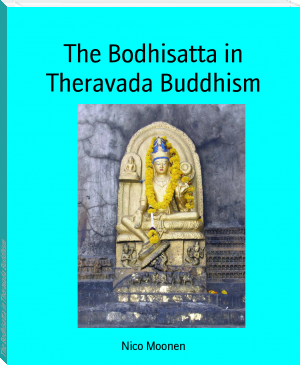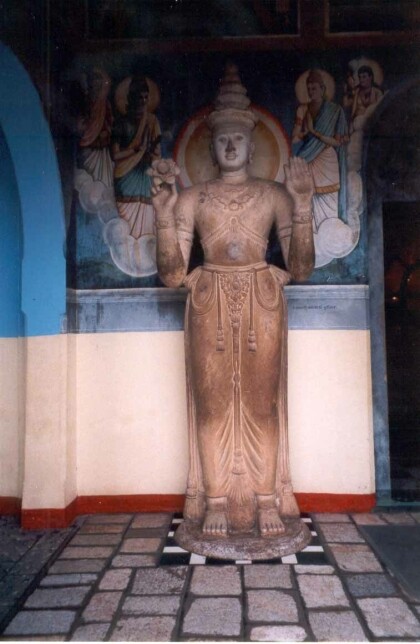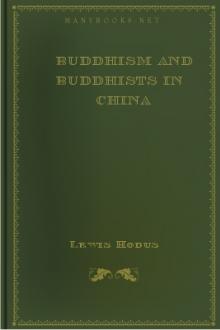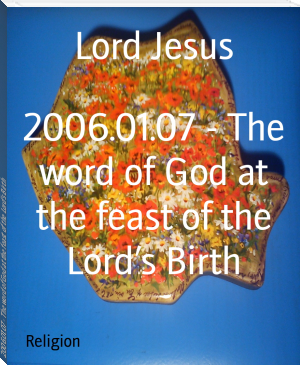The Bodhisatta in Theravada Buddhism by Nico Moonen (best books to read now .TXT) 📖

- Author: Nico Moonen
Book online «The Bodhisatta in Theravada Buddhism by Nico Moonen (best books to read now .TXT) 📖». Author Nico Moonen
The (Mahā) Bodhisatta is the one who is destined to Buddhahood. Before he starts his career, he takes the decision to become a Buddha in the future. He takes this decision in the presence of a living Buddha who predicts that his aspiration will succeed. That aspiration must also be repeated later in the presence of all subsequent Buddhas who will confirm his aspiration. The Bodhisatta must also perform a meritorious deed towards every Buddha.
The aspiration succeeds only if certain circumstances are fulfilled. When the aspiration is made for the first time, he should be a man who is able to attain perfect holiness. Further, he should by then have abandoned the home life.
During his long career he must practice ten virtues or perfections. He must develop and perfect them. Owing to these and other virtuous activities he acquires the marks of a Great Man. These marks mainly relate to his character and virtue. The stories from the Buddhavamsa about 24 former lives of the Buddha Gotama have educational value and need not be taken literally. They illustrate the extraordinary degree of virtue and unselfishness required to become a Buddha.
Before his last existence on this earth the Bodhisatta remains in the Tusita heaven. From there he descends into a womb where he stays exactly ten lunar months. His birth is stainless.
There are three kinds of Mahā Bodhisattas: Bodhisattas with wisdom, with energy or with devotion as basis.
The Bodhisatta has not attained holiness. Therefore the four unique marks ascribed to him, cannot apply to a Bodhisatta. They are applicable to an Arahant (saint).
The Bodhisatta in Theravāda is not yet a perfect man. And as an imperfect man he has shortcomings and he can make mistakes, of course. Be he exerts himself from the beginning of his career to perform good unselfish actions. As a result he acquires during his career certain good qualities: health and long life, influence, beauty and wisdom. And in his last existence, the life in which he becomes a Buddha, he also acquires the special marks of a Buddha.
Bodhisatta, Anuradhaprura, Sri Lanka

Stories of the so-called previous lives of the Buddha Gotama are called Jātakas. There are 547 of those stories, also called birth-stories. These stories are used for teaching the great lessons of morality.[176] The Jātaka stories are divided into 22 books (Nipāta), corresponding to the number of stanzas in them. In the first book are found the Jātakas with one stanza; in the second book those with two stanzas, etc.[177]
According to Venerable Dr. Phra Maha Tuan Pim-Aksorn the Jātakas were told by the Buddha himself during his sermons at several places and were then re-narrated in detail by the Venerable Ānanda and approved by the 499 other Arahants of the first Council.[178] According to another source the stories were told by the Buddha to his disciples at Śrāvasti, and re-narrated by the scholar Ārya Śūra.[179] But are the Jātakas really stories of previous lives of the Buddha; were they told by the Buddha himself?
Kern states that the Jātakas are events with a moral meaning. Essentially they do not differ from the Indian fables and tales in the Pañçatantra.[180] Originally they were probably simple instructive stories. According to Kern the translation “birth-story” for Jātaka is wrong. The term jātakam was derived from jātam (something that is born, that happened) with the addition of the suffix ka meaning smaller or diminutive. This gives the meaning: a small incident that happened, or a scene, a story, a fragment, a fable.[181] Speyer agrees with this meaning.[182]
The research undertaken by Winternitz led to the same conclusion.[183] In the Jātaka-stories old and new elements are mixed together. A Jātaka is a story in which the Bodhisatta in one of his former lives plays a part as hero or spectator. Every Jātaka-story starts therefore with the words “In such-and-such a time the Bodhisatta was reborn in the womb of such and such being” and then follows the story. In that way every popular story or legend could be changed into a Jātaka. All that was required was that a suitable human, animal or divine being that appeared in the story could be identified as the Bodhisatta. In that way, also, stories that originally had nothing to do with the Dhamma, could become “Buddhist”. The monks of yore knew that the people of India liked to listen to stories. Therefore they used all possible stories, fables, legends etc. to preach the Dhamma in a popular way.[184]
In ancient times it was not always considered necessary to transform the tales into the Jātaka form so that several stories can be found in the Pāli Canon without the key person being identified as the Bodhisatta. According to Winternitz it was only later that these stories were further transformed into the familiar Jātaka form. He also says that monks told those stories in their sermons or used the stories themselves as sermons.[185]
The original book of the Jātakas contained only the verses. It was compiled in North-India before the time of Emperor Asoka. In Indian stories a mixture of prose and verses was popular and the stories that were transformed into Jātakas, originally contained both. But only the verses were included in the Pāli Canon, without the prose stories. Yet, the stories that belong to those verses must have also been handed down. For without the prose stories the verses are incomprehensible.[186] The oldest Jātakas are prose parables, fables, legends, ballads, anecdotes, without a frame and without verses. Most of them were pre-Buddhist but have been cleverly transformed to connect them with the life of the Buddha. In all these stories the Bodhisatta plays a more or less important part.[187] In the earliest forms of the Jātakas the Buddha in his former life is never identified with an animal; he is only identified with famous sages or teachers. The canonical versions are believed to be a later development of the earlier Jātakas.[188]
The Jātakas were originally transmitted orally; but after the Pāli Canon was agreed, the prose was recorded in the form of a commentary. The final version was that of the commentary only and not of the original full version. That commentary was written down between the second and the fifth century C.E. It was based on the tradition of the Great Monastery (Mahā Vihara) at Anuradhapura, Sri Lanka. According to some the commentator was Buddhaghosa. But that is not possible. The commentary contains both the stanzas and the stories in prose. Further it has a framework with an introduction and a connecting explanation. The commentary is a translation of the Sinhalese commentary into Pāli. In that way the tradition handed down from the third century B.C. is maintained[189]
In that commentary each of the stories of the Jātakas is divided into five parts:
The story of the present (paccuppanna-vatthu). In this part we find the occasion on which the Buddha narrated the story.
The story of the past (atīta-vatthu). Here is narrated in prose the story of one of the past lives of the Bodhisatta.
The verses or stanzas (gāthā).
The brief exposition (veyyākaraņa), which is a grammatical explanation.
The connection (samodhāna). In this section the Buddha generally identifies the principal characters, referred to in part one, with those whose past actions have been described in part two.[190]
The Jātaka-book does not contain all Jātaka-stories that were in circulation during the initial period of Buddhism nor were those fables, legends and parables in the original collection specifically Buddhist. They originated as popular Indian stories and legends from which the early Buddhists probably made a selection and then adapted them. The ethics in them is simple.[191] Further it is unlikely that all the Jātakas are by author. At most they could have been arranged by one person. Several parts are added to or re-narrated from earlier versions. From the language it may be concluded that several Jātakas originated in the second century B.C.E.[192]
From the foregoing it is evident that the prose parts of the Jātakas are not as old as the verses. And through the translation and retranslation several modifications could have been made as well. Some Jātakas, containing for both verses and prose, could belong to the third century B.C.E. in the Buddhist tradition. This is supported by Jātaka-pictures on reliefs on the stūpas of Bharhut and Sāñchi, dating from the third or second century B.C.E. Several aphorisms and legends might belong to pre-Buddhist times but for the most part the verses date at most from the third century B.C.E. and one part of the prose dates back to the third or second century B.C.E. It is thought that only one part dates from the Current Era (C.E.).[193] Some of the stories were already very old when they were originally incorporated into the Buddhist tradition not later than beginning of the third century B.C.E. About 60-70% of them have no verses.[194]
In the final version of the Jātakas we find:[195]
Fables; lessons about worldly wisdom. Only a few of them are specifically Buddhist.
Legends and myths, among which many animal legends. Most of these have no connection to Buddhism. In a few cases they have a Buddhist tendency.
Short anecdotes that have nothing Buddhistic about them.
Sagas and short stories with a lot of adventures and sometimes with a number of tales interspersed. The only reason they can be considered Buddhist is that the hero in the stories is the Bodhisatta.
Moralistic stories.
Aphorism which contain the Brahmin ideal.
Pious legends that are only





Comments (0)